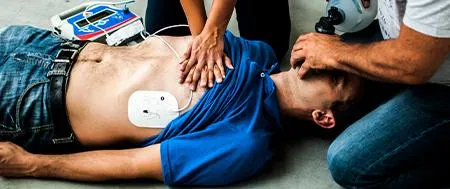Rutland First Aid Training
BLOG

Dental First Aid
Medical emergencies can and do occur in primary care dental practices, with approximately 60% of dentists encountering at least one such emergency annually (Müller et al., 2008). Recognising this, the General Dental Council (GDC) underscores the importance of maintaining up-to-date knowledge and skills in managing these situations. The GDC recommends that dental professionals complete a minimum of 10 hours of medical emergency training as part of their continuing professional development (CPD) cycle, including at least 2 hours annually (GDC, 2018). Regular training is critical, as opportunities to gain practical experience in real-life emergencies are uncommon.
The evolution of dental teams has introduced various dental care professionals (DCPs), such as dental nurses, dental hygienists, and dental therapists, into the management of medical emergencies. According to the GDC's ‘Standards for the Dental Team,’ at least two team members must be present and prepared to handle medical emergencies whenever treatment is underway. Furthermore, all staff—whether GDC-registered or not—should understand their roles in an emergency, receive adequate training, and participate in regular team-based simulations of clinical scenarios to ensure preparedness (GDC, 2013a).
Preparedness for medical emergencies is essential in the dynamic environment of a dental practice. Ensuring the safety of patients and staff requires comprehensive training, adherence to professional standards, and ready access to life-saving equipment and medications. The GDC highlights Medical Emergencies as a key component of verifiable CPD, emphasising the importance of annual training and rigorous compliance with the Resuscitation Council (UK) guidelines.
This blog explores critical aspects of medical emergency preparedness in dental practices, including training requirements, essential equipment and medications, and the roles and responsibilities of dental professionals in emergency situations. By prioritising these measures, practices can foster a safe, confident, and compliant environment for both staff and patients.
Highlighted Questions:
Who can administer drugs from the medical drugs kit in a dental practice?
What are the GDC CPD requirements for “Outcome C”?
What should be included in our medical drugs kit to meet GDC and Resuscitation Council standards?
Why is medical emergency training essential for dental practice staff?
What are the GDC-recommended CPD hours for medical emergency training?
How often should emergency training be conducted, and what should it include?
What equipment is required to manage emergencies effectively in a dental practice?
What are the rules around dental hygienists, therapists, and clinical dental technicians using emergency drugs?
How does simulated emergency training enhance team preparedness?
Dental Practice First Aid Requirements and Training
The General Dental Council (GDC) has identified Medical Emergencies as one of the three highly recommended topics for verifiable Continuing Professional Development (CPD). To comply with GDC standards, dental practices must ensure that regular medical emergency training is conducted following guidance from the Resuscitation Council (UK).
Why Medical Emergency Training is Essential for Your Practice
GDC registrants must complete 10 hours of medical emergency CPD during each cycle, with a recommendation of at least 2 hours annually.
There must be at least two people available to manage potential emergencies during treatment.
All staff members (including non-registered personnel) should be trained and understand their roles in the event of a patient collapse or emergency.
Simulated emergency training ensures all staff are prepared and confident to act when required.
The GDC further endorses the Resuscitation Council's Quality Standards: Primary Dental Care as the main guidance document for dental professionals. Additionally, clinical areas must have immediate access to an Automated External Defibrillator (AED) and a fully stocked emergency drugs kit.
What are the GDC CPD requirements for “Outcome C”?
The General Dental Council (GDC) sets clear expectations for dental practices to be prepared for medical emergencies. This includes ensuring all staff—from clinical to non-clinical—are trained in essential life-saving skills like CPR and the use of an Automated External Defibrillator (AED).
Training should encompass recognising cardiorespiratory arrest, initiating effective CPR (including paediatric-specific techniques for practices treating children), and delivering care with the appropriate equipment. Annual updates, induction training for new staff, and hands-on simulation exercises are key to maintaining these critical skills.
Minimum Equipment and Medication Requirements
It is important that all drugs should be stored together in a purposely designed storage bag or container and all members of the team should know where it is stored. Even though, as a Dental Care Practitioner you may not be the ones to actually administer the emergency drugs, practising as part of a team will allow you to identify roles and responsibilities in terms of getting the drug kit, phoning for an ambulance, assisting with CPR etc
To comply with Resuscitation Council (UK) guidance, your practice should have the following equipment and medications available to manage common medical emergencies:
Essential Equipment in a Dentist Practice
Adhesive defibrillator pads
Automated external defibrillator (AED)
Clear face masks for self-inflating bag (sizes 0, 1, 2, 3, 4)
Oropharyngeal airways (sizes 0, 1, 2, 3, 4)
Medical oxygen cylinder
Oxygen masks with reservoir
Oxygen tubing
Pocket mask with oxygen port
Portable suction (e.g., Yankauer)
Protective equipment – gloves, aprons, eye protection
Razor
Scissors
Self-inflating bag with reservoir (adult and child sizes)
Syringes and needles (if ampules are in the emergency drugs kit)
Emergency Medications in a Dentist Practice
Adrenaline/Epinephrine injection (1 in 1000, 1 mg/mL, 1 mL amps)
Aspirin dispersible tablets (300 mg)
Glucagon injection (1-unit vial with solvent)
Glucose (for administration by mouth)
Glyceryl trinitrate spray
Midazolam oromucosal solution
Medical oxygen
Salbutamol aerosol inhalation (100 micrograms/metered inhalation)
Note: Oxygen cylinders must allow for a flow rate of 15 L/min for at least 30 minutes, or until emergency services arrive. A second cylinder may be necessary depending on practice policies.
The use of intravenous drugs in a dental practice setting is not encouraged. Intramuscular, inhalational, subingual, buccal and intranasal routes are all much easier to administer drugs in an emergency. Wherever possible drugs in solution form should be held in pre-filled ready-to-adminster syringes (Resuscitation Council, 2006)
Dental practices need to be checking emergency medication on at least a weekly basis both to ensure that they are present and also that they are in date. Processes should also be in place for a means of rapid replenishment should emergency medications be used or for those that are coming up to their expiry. Responsibility for checking resuscitation equipment rests with the individual dental practice where the equipment is held. This processs should be designated to named indiviudals and checking should be the subject of local audit (Resuscitation Council 2006)
Roles within a Dental Practise
Due to the dynamic and busy nature of a primary dental practice, the roles undertaken by staff members during a medical emergency can vary from day to day.
Administration Staff
Receptionists and practice managers, who are not registered with a professional body, typically have limited medical training. While they cannot administer any prescription-only medicines (POMs), they can be trained in basic life support (BLS), cardiopulmonary resuscitation (CPR), and the use of oxygen and an automated external defibrillator (AED). If appropriately trained then their primary responsibilities in an emergency often include contacting emergency services, relaying critical information to call handlers, and guiding emergency responders to the patient. In some cases, administrative staff may also hold qualifications as trained dental nurses.
Dental Nurses
Dental nurses are registered with the General Dental Council (GDC) and undergo training that typically spans 12 to 24 months, combining theoretical knowledge with practical experience in a dental practice or hospital setting (GDC, 2024). Their primary role is to support dentists in delivering oral healthcare, distinct from the general healthcare focus of adult nurses registered with the Nursing and Midwifery Council (NMC).
In a medical emergency, dental nurses must “support the patient and their colleagues” (GDC, 2013b). While they cannot administer POMs independently, they are authorised to deliver injectable adrenaline, glucagon, and other non-injectable emergency drugs commonly available in dental practices, excluding midazolam. They are trained in BLS, CPR, oxygen administration, and AED operation. Dental nurses often take responsibility for preparing the emergency kit, keeping records, and tracking time during an incident. Senior dental nurses may also assess and manage patients in line with agreed emergency clinical procedures and training (SDCEP, 2014). Additionally, dental nurses can monitor blood pressure, blood glucose, and oxygen saturation levels and may act as team leaders.
Dental Hygienists and Therapists
Dental hygienists and therapists are also registered with the GDC and hold a diploma or Bachelor of Science in their respective fields (GDC, 2023a). They are trained in BLS, CPR, oxygen administration, and AED use.
Hygienists and therapists are authorised to administer all medical emergency drugs listed in the British National Formulary (BNF) “Guidelines for Medical Emergencies – Prescribing in Dental Practice” (NICE, 2023), except for midazolam. As a controlled drug, midazolam may only be administered under the supervision of a dentist or when listed on a patient-specific directive (PSD). Dental hygienists and therapists may also assume the role of team leader during a medical emergency.
Dentists
Dentists, registered with the GDC and holding a Bachelor of Dental Surgery (BDS) or equivalent qualification (GDC, 2023b), are trained to perform all emergency duties, including BLS, CPR, AED use, and the administration of all emergency drugs available in dental practices. Dentists typically lead the team during medical emergencies, although this role can be assumed by others depending on the situation.
For practices offering sedation services, dentists and dental care professionals (DCPs) must complete annual Immediate Life Support (ILS) training (SDCEP, 2017).
History of Prescribing and Administering POM for Dental Hygienists and Dental Therapists
From 12th June 2024, amendments to the Human Medicines Regulations 2012 came into effect, allowing suitably trained dental therapists and hygienists to supply and administer specified medicines without the need for a PSD or patient-group direction (PGD) from a dentist (England 2024).
Previously, owing to an omission during the update to the Dentists Act 1984, dental hygienists and therapists were required to have either a PSD or PGD from a dentist or doctor to administer or supply prescription-only medicines (POMs). A PSD is a document tailored to the needs of an individual patient, enabling the safe supply or administration of medicines while managing identified risks. It must include details such as the patient’s name, the medicine’s form, strength, route of administration, dosage, frequency, treatment dates, number of doses, and the prescriber’s signature. Meanwhile, a PGD is a written instruction allowing specified health professionals to sell, supply, or administer named medicines in predefined clinical situations. Under the Human Medicines Regulations 2012, a PGD required signatures from both a dentist and a pharmacist. Practices providing NHS primary dental services also needed the PGD to be signed on behalf of the commissioning body (Evans, 2014).
Since 2019, the British Association of Dental Therapists (BADT) and the British Society of Dental Hygiene and Therapy (BSDHT) have lobbied for legislative changes to enable dental hygienists and therapists to supply and administer POMs under specific exemptions. The 2024 amendments to the Human Medicines Regulations now allow appropriately trained dental therapists and hygienists to supply and administer certain medicines without requiring a PSD or PGD from a dentist.
However, these new regulations do not extend to the administration of the controlled drug midazolam. For dental hygienists and therapists to administer midazolam in a medical emergency, a PSD remains mandatory (The Human Medicines Regulations 2024).
Who Can Administer Drugs in a Dental Practice?
The British Dental Council (BDC) endorses the Resuscitation Council’s guidance, which states that clinical dental settings staffed by dentists, hygienists, and therapists must have an emergency drugs kit available. Further details on the contents of these kits can be found in the British National Formulary (BNF) guidelines, as outlined by the National Institute for Health and Care Excellence (NICE). For convenience, the essential drugs have been listed in previous sections.
Clinical Dental Technicians: The BDC acknowledges that the Human Medicines Regulations 2012 prohibit clinical dental technicians from purchasing or holding prescription-only medicines found in an emergency drugs kit. Consequently, clinical dental technicians are not expected to possess or be trained in the use of such kits. Their responsibilities in a medical emergency are limited to their training in basic life support (BLS) and assisting as part of a team where necessary.
In addition, all DCPs can administer non-injectable medical emergency drugs, including aspirin, oral glucose, glyceryl trinitrate (GTN) spray, oxygen and salbutamol, for the purpose of saving a life. They must be competent in the use of the drugs (Scottish Dental Clinical Effectiveness Programme (SDCEP) (2023). DCPs cannot administer the controlled drug, midazolam.
Health and Safety: First Aid in the Workplace
In addition to recognising and managing medical emergencies that may occur in a dental practice, the entire dental team should be equipped to handle basic first aid procedures effectively.
Health and Safety (First Aid) Regulations 1981
Under the First Aid Regulations, all workplaces are required to provide adequate first aid provisions for their employees. However, it is important to note that there is no legal obligation to offer first aid treatment or facilities to non-employees, such as patients or visitors.
To comply with general Health and Safety requirements, practices must carry out a risk assessment to identify workplace hazards and occupational risks specific to dentistry. The outcomes of this assessment will determine the level of first aid provision necessary for both the premises and the staff.
Essential First Aid Requirements for Dental Practices
In line with clinical governance and Health and Safety regulations, every dental practice must ensure the following:
Basic Life Support (BLS) Training: All staff should be trained and hold valid certification in basic life support.
Emergency First Aid Trained Staff: Workplaces with more than five employees must have at least one person trained in emergency first aid.
First Aid Kit: Every practice must have a readily accessible first aid kit, separate from the emergency drugs and oxygen cylinders required for medical emergencies.
Accident Book: An accident book must be available to document any incidents occurring on the premises, whether they involve staff, patients, or visitors. This excludes major incidents, which are reported separately.
Reassurance and Support: In the event of an emergency, the dental team must provide immediate reassurance and assistance to the affected individual. This includes administering BLS when necessary until professional medical assistance arrives.
By adhering to these guidelines, dental practices can maintain a safe and compliant environment for both employees and visitors, ensuring readiness to manage emergencies effectively
How Rutland First Aid Training Can Help Your Practice
We offer tailored training solutions to ensure your team is compliant, confident, and capable of handling medical emergencies.
Course 1: Basic CPR and AED Training
Who Should Attend?
All staff involved in patient care or administration - from Receptionist to Clinicians, particularly those who have no prior knowledge of CPR and AED or just needing a solid review of skills.
A great starting point for teams new to structured medical emergency training.
It is recommended that all team members complete a course of basic life support training once a year. Take time to review your practice policy and ensure you are familiar with it
More information on the course can be found here
Course 2: Dental Medical Emergencies
Who Should Attend?
GDC-registered personnel looking for more in-depth training and annual updates to maintain compliance and skills.
More information on the course can be found here
Course 3: Medical Emergency Scenario Training
A hands-on, team-based course ensuring all staff understand their roles in a simulated emergency.
Reinforces protocols and improves confidence in managing real-life scenarios.
Tailored scenarios to address your practice's specific needs and challenges.
Who Should Attend?
All members of the dental team, including administrative staff, dental nurses, hygienists, and therapists. Regular scenario-based training helps the entire team work together seamlessly during emergencies.
This course is great for team building and 'testing' of the practice emergency plan to ensure everyone happy with their roles and able to deliver what is expected of them.
More information on the course can be found here
Your Next Steps to Compliance
Ensure your dental practice meets the GDC and Resuscitation Council standards by investing in high-quality medical emergency training.
Contact Rutland First Aid Training Today
Ensure your team is prepared, compliant, and confident. Let us help you meet GDC requirements while fostering a safer environment for your patients and staff.
Rutland First Aid Training provides this information for guidance and it is not in any way a substitute for medical advice. Rutland First Aid Training is not responsible or liable for any diagnosis made, or actions taken based on this information.
Hear what our first aid students have to say...
TESTIMONIALS


A really good training course, very professionally presented by Tracy. I’ve been on lots of training courses over the years and too often they can be soporific! Tracy is one of those rare training professionals who can deliver training and keep a person interested all day! Great course. Highly recommended!

Alan Eager
Google Review


Rutland first aid are professional yet kept the courses fun and interactive and use some very interesting props. As a driving instructor I wanted to be able to deal with any issues with my students but also any issues I may come across on the roads. Highly recommended.

James Dames
Google Review


Couldn't recommend Tracy and her team enough for a first aid course. Having to renew it every 3 years used to send me to sleep. Not with these guys! Professional, up to date and with lots of toys to play with, without the death by powerpoint.

Mike Gould
Google Review

Here at Rutland First Aid Training we strive to provide high quality, personalised, fun and informative first aid courses.
Our courses are recognised by HSE, Ofsted and follow ILCOR guidelines.
Short Cuts
Find what you are looking for:
Dental CPD Courses
Get In Touch
If you have any questions or would like to discuss your requirements in further detail, our team are always happy to assist you.
Unit 2B Station Approach, Oakham, Rutland LE15 6QW
@ 2025 Copyright Rutland First Aid Training. All rights reserved.
Rutland First Aid Training is a trading name of Dive Rutland Limited. Company No: 9433835.




